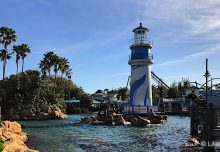 Following the shocking death of a trainer working with one of the killer whales just after a performance in February 2010, SeaWorld withdrew its orca trainers from the tanks at all of its parks. Now, no trainers will be in the water during any killer whale performances—at any SeaWorld park. Yet the theme of this show, One Ocean, which debuted in April 2011, is that humans and animals are connected, that ours is “one world united by one ocean,” the narration says.
Following the shocking death of a trainer working with one of the killer whales just after a performance in February 2010, SeaWorld withdrew its orca trainers from the tanks at all of its parks. Now, no trainers will be in the water during any killer whale performances—at any SeaWorld park. Yet the theme of this show, One Ocean, which debuted in April 2011, is that humans and animals are connected, that ours is “one world united by one ocean,” the narration says.
One Ocean has as many as six orcas at one time in the tank, fronting the 6,000-seat Shamu Stadium. Usually performing in pairs and in the occasional foursomes, the mighty mammals swim and leap and even soar from the water for a full somersault. Typically, at least two orcas are simultaneously swimming past fountains, through curtains of water, and under shooting jets of water.
 As with most celebrities, these killer whales are known by stage names—most notably, Shamu and Baby Shamu. Actually, at least 20 orcas have been born in the various SeaWorlds, so the animals on display here are of varying sizes and ages. While the orcas are all undeniably awe-inspiring, watching them go back and forth in similar patterns for nearly half an hour frankly gets a bit boring, and the nature footage screened on the blotchy Jumbotron (which is completely illegible from the stadium’s sides) aren’t any more compelling. It’s also embarrassing watching the trainers try to dance and clap to the insipid soft rock sound track; apparently anyone with stage presence is sent to the sea lion show.
As with most celebrities, these killer whales are known by stage names—most notably, Shamu and Baby Shamu. Actually, at least 20 orcas have been born in the various SeaWorlds, so the animals on display here are of varying sizes and ages. While the orcas are all undeniably awe-inspiring, watching them go back and forth in similar patterns for nearly half an hour frankly gets a bit boring, and the nature footage screened on the blotchy Jumbotron (which is completely illegible from the stadium’s sides) aren’t any more compelling. It’s also embarrassing watching the trainers try to dance and clap to the insipid soft rock sound track; apparently anyone with stage presence is sent to the sea lion show.
Sitting in the First Few Rows of One Ocean Will Get You Soaked!
 One thing has not changed from the previous choreographed show: The famous splash zone—the half-dozen or more rows of seats closest to the tank—is still a gonna-get-wet area for the guests there. Depending on which whales are doing the splashing with their tails, gallons and gallons of 55°F salt water are flung into those first rows. When the largest of the orcas performs that trick, it is a real crowd-pleaser, with the audience howling and cheering as folks get splashed. And some in the crowd, especially the under-12 set, make it a point to be in the water’s path. During the summer and holidays, SeaWorld stages special versions of its Shamu shows just before the park closes. The orca’s act remains pretty much the same, but the music is swapped out for rock and roll (or gospel, depending on the season), and the animal antics are supplemented with a brief pyrotechnic finale, launched over the lake behind the stadium. As far as fireworks go, SeaWorld’s current displays are closer in quality to Universal’s than Disney’s and don’t equal the old IllumiNations-esque laser show, which was watched from the now-unused Bayside Stadium. If you didn’t see the daytime Shamu show, you should stick around for the evening one, but it’s probably not worth waiting around for if you’ve already seen everything in the park long before showtime.
One thing has not changed from the previous choreographed show: The famous splash zone—the half-dozen or more rows of seats closest to the tank—is still a gonna-get-wet area for the guests there. Depending on which whales are doing the splashing with their tails, gallons and gallons of 55°F salt water are flung into those first rows. When the largest of the orcas performs that trick, it is a real crowd-pleaser, with the audience howling and cheering as folks get splashed. And some in the crowd, especially the under-12 set, make it a point to be in the water’s path. During the summer and holidays, SeaWorld stages special versions of its Shamu shows just before the park closes. The orca’s act remains pretty much the same, but the music is swapped out for rock and roll (or gospel, depending on the season), and the animal antics are supplemented with a brief pyrotechnic finale, launched over the lake behind the stadium. As far as fireworks go, SeaWorld’s current displays are closer in quality to Universal’s than Disney’s and don’t equal the old IllumiNations-esque laser show, which was watched from the now-unused Bayside Stadium. If you didn’t see the daytime Shamu show, you should stick around for the evening one, but it’s probably not worth waiting around for if you’ve already seen everything in the park long before showtime.
TOURING TIPS We’re not kidding when we say that gallons of chilly salt water are splashed onto the audience. You will get soaked if you sit in the first few rows. If you or the kids think you’re up for it, you might want to bring some extra clothes to change into after the cold shower. You should also leave your cameras with someone out of the range of the corrosive salt water. Though this is a large stadium, you must arrive at least 20 minutes before the scheduled start to get a seat. Warming up the crowd before the shows is a video on training the orcas. There may be as few as two shows a day or as many as four; check the daily schedule for times.
For a complete review of all attractions at SeaWorld, check out Beyond Disney: The Unofficial Guide to SeaWorld, Universal Orlando, & the best of Central Florida by Bob Sehlinger and Seth Kubersky.
Photo credits
By Curimedia | P H O T O G R A P H Y [CC BY 2.0], via Wikimedia Commons





